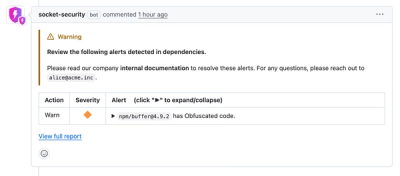
Security News
Crates.io Users Targeted by Phishing Emails
The Rust Security Response WG is warning of phishing emails from rustfoundation.dev targeting crates.io users.
@traefiklabs/faency
Advanced tools
This is the React component library and design system for Traefik Labs.
Built with React, Typescript, Stitches and Radix UI Primitives.
You can find the Storybook with an example for every component in this library here.
npm install @traefiklabs/faency@next
# or
yarn add @traefiklabs/faency@next
Then you need to wire up the FaencyProvider which will hold the context with the Theme configuration and everything global that the components will need to work well.
The provider accepts one parameter besides the
children, which is theprimaryColor, that will be used to build the colors used on the Theme. This color can be one of the colors exported by theStitchesconfig, just by adding$as a prefix, or can be any string that represents a CSS color.
import { FaencyProvider } from '@traefiklabs/faency';
const App = () => <FaencyProvider primaryColor="$blue8">{/* your app */}</FaencyProvider>;
Then you are ready to import components and use them on your project:
import { Flex, styled } from '@traefiklabs/faency';
const Container = styled(Flex, {
padding: '$3',
bg: '$black', // alias for backgroundColor
mx: '$2', // alias for margin left and right
});
const MyComponent = () => <Container>{children}</Container>;
docker run -it -v $(pwd):/usr/local/src/ -w /usr/local/src/ -p 3000:3000 node:latest bash
yarn install
Stitches package needs to be patched after the upgrade to TypeScript version 5. You can run this script after installing the dependencies to apply the patch:
yarn patch-package
yarn storybook
At this point, Storybook should automatically open up in your browser and you can start coding, it has hot reload so it will automatically re-render whenever a change is detected on the code.
We use Stories to demonstrate how components can behave and which variants they can take, so it's expected that every component has a Story. Check out how to create stories in the Storybook Docs.
Pull requests are always welcome, but if you have a big change that you would like to work on, it's recommended to open an issue, so we can discuss it beforehand.
A good PR is small, focuses on a single feature or improvement, and clearly communicates the problem it solves.
Try not to include more than one issue in a single PR. It's much easier for us to review multiple small pull requests than one that is large and unwieldy.
Note we follow conventional commits.
Please follow the provided PR template.
We use semantic-release/semantic-release to automagically release any commit on the master branch.
Recommended conventional commit types:
["build", "chore", "ci", "docs", "feat", "fix", "revert", "test"]
build/chore: Changes that affect the build system or external dependencies (example scopes: gulp, broccoli, npm)ci: Changes to CI configuration files and scripts (examples: CircleCi, SauceLabs)docs: Documentation (comments) only changesfeat: A new featurefix: A bug fixrevert: Reverts a previous committest: Adding missing tests or correcting existing testsBreaking change syntax:
<type>!: <description>
Matching between commit type and release
[
{ breaking: true, release: 'major' },
// types impacting release version
{ revert: true, release: 'patch' },
{ type: 'feat', release: 'minor' },
{ type: 'fix', release: 'patch' },
{ type: 'perf', release: 'patch' },
];
See semantic-release/commit-analyzer for more information.
FAQs
Traefik Labs design system
The npm package @traefiklabs/faency receives a total of 189 weekly downloads. As such, @traefiklabs/faency popularity was classified as not popular.
We found that @traefiklabs/faency demonstrated a healthy version release cadence and project activity because the last version was released less than a year ago. It has 3 open source maintainers collaborating on the project.
Did you know?

Socket for GitHub automatically highlights issues in each pull request and monitors the health of all your open source dependencies. Discover the contents of your packages and block harmful activity before you install or update your dependencies.

Security News
The Rust Security Response WG is warning of phishing emails from rustfoundation.dev targeting crates.io users.

Product
Socket now lets you customize pull request alert headers, helping security teams share clear guidance right in PRs to speed reviews and reduce back-and-forth.

Product
Socket's Rust support is moving to Beta: all users can scan Cargo projects and generate SBOMs, including Cargo.toml-only crates, with Rust-aware supply chain checks.